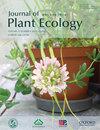中亚温带荒漠苔藓C、N、P、K的化学计量特征及其与土壤养分和环境的关系
IF 3.9
2区 环境科学与生态学
Q2 ECOLOGY
引用次数: 0
摘要
先前的研究表明,苔藓的化学计量特征受到苔藓斑块大小、灌木和沙漠环境的影响。研究不同空间分布区域的苔藓化学计量对于理解苔藓的生长和适应策略至关重要。在本研究中,选择了古尔班通古特沙漠生物土壤结皮中的优势苔藓(Syntricia caninervis Mitt.)和苔藓斑块下的土壤,以确定它们在不同沙丘和地点的化学计量。苔藓化学计量和土壤有效养分受除苔藓C以外的不同分布区的显著影响。Nbelowground,Paboveground vs。Pbelowground和Kaboveground对。苔藓的K标度指数分别为0.251、0.389和0.442。苔藓地上和地下部分的N与P的比例指数分别为0.71、0.84。苔藓的化学计量不成比例地分布在地上和地下部分。苔藓的N、P、K元素受年平均降水量、经度和土壤养分的影响。苔藓的营养成分受空间分布、年平均气温(MAT)、MAP和土壤营养成分的影响。在温带沙漠中,苔藓的生长受到N元素的限制。本研究提供了苔藓在不同空间尺度上的C、N、P和K的化学计量特征,并探讨了它们与环境变量的关系,有助于了解N、P、K的营养模式和利用策略,以及它们对全球沙漠气候变化的潜在响应。本文章由计算机程序翻译,如有差异,请以英文原文为准。
Moss C, N, P and K stoichiometry and their relationships are related to soil nutrients and environment in a temperate desert of central Asia
Previous studies showed that moss stoichiometric characteristics were influenced by moss patch size, shrubs and the environment in the desert. The study of moss stoichiometry in different spatial distribution areas is crucial for an understanding of growth and adaptation strategy of the mosses. In this study, the dominant moss (Syntrichia caninervis Mitt.) of biological soil crusts, and soil under the moss patches in the Gurbantunggut Desert were selected to determine their stoichiometry in different dunes and sites. Moss stoichiometry and soil available nutrients were significantly influenced by different distribution areas except for moss C. The Naboveground vs. Nbelowground, Paboveground vs. Pbelowground, and Kaboveground vs. Kbelowground scaling exponents of moss were 0.251, 0.389, 0.442, respectively. The N vs. P scaling exponents were 0.71, 0.84 in above- and below-ground parts of moss. Moss stoichiometry was disproportionately distributed in the above-ground and below-ground parts. Moreover, moss N, P and K elements were influenced by mean annual precipitation (MAP), longitude and soil nutrients. The nutrients of moss were affected by spatial distribution, mean annual temperature (MAT), MAP and soil nutrients. The growth of moss was limited by N element in the temperate desert. This study provides the stoichiometric characteristics of C, N, P and K of moss at different spatial scales, and explores their relationships with environmental variables, which can help understand nutrient patterns and utilization strategy of N, P and K, and their potential responses to global climate changes in desert.
求助全文
通过发布文献求助,成功后即可免费获取论文全文。
去求助
来源期刊

Journal of Plant Ecology
生物-植物科学
CiteScore
4.60
自引率
18.50%
发文量
134
审稿时长
3 months
期刊介绍:
Journal of Plant Ecology (JPE) serves as an important medium for ecologists to present research findings and discuss challenging issues in the broad field of plants and their interactions with biotic and abiotic environment. The JPE will cover all aspects of plant ecology, including plant ecophysiology, population ecology, community ecology, ecosystem ecology and landscape ecology as well as conservation ecology, evolutionary ecology, and theoretical ecology.
 求助内容:
求助内容: 应助结果提醒方式:
应助结果提醒方式:


